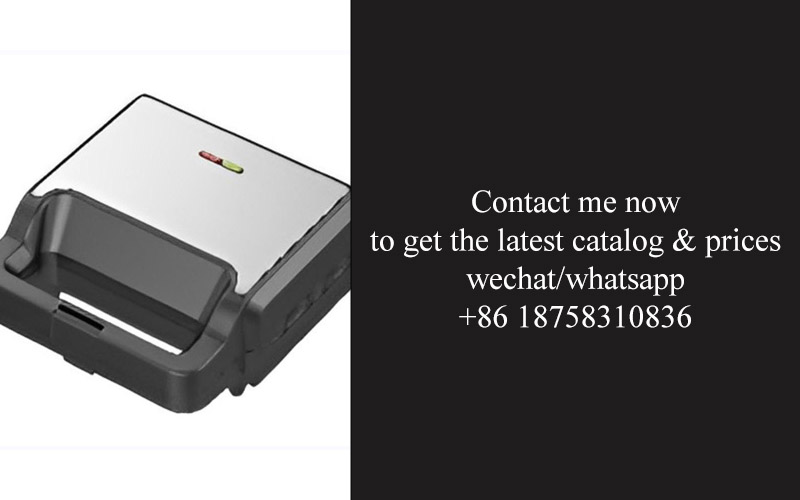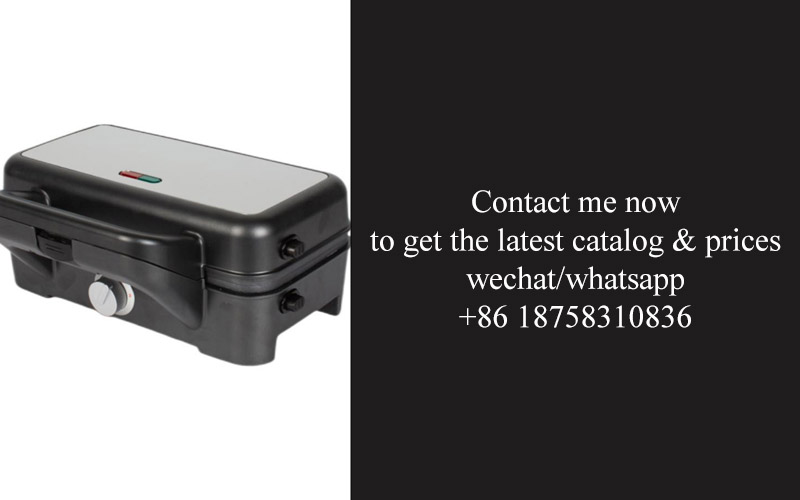Address
304 North Cardinal
St. Dorchester Center, MA 02124
Work Hours
Monday to Friday: 7AM - 7PM
Weekend: 10AM - 5PM
Address
304 North Cardinal
St. Dorchester Center, MA 02124
Work Hours
Monday to Friday: 7AM - 7PM
Weekend: 10AM - 5PM

In a world where technology and design intertwine to shape the way we live, the kitchen has emerged as a canvas for innovation. At the heart of this culinary revolution are kitchen appliances, and one particular technology has been quietly reshaping their landscape—integrated metal stamping for sandwich plates. This article delves into the evolution of these plates, the art of metal stamping, and the myriad benefits it brings to the kitchen appliance industry. We’ll explore the latest market trends and consumer insights, showcase successful case studies, and gaze into the future of sandwich plate design, ultimately reflecting on the profound impact of integrated metal stamping on the world of kitchen appliances.
The sandwich plate has come a long way since its inception in kitchen appliances. Once a simple, functional piece of cookware, it has now evolved into a versatile and integral part of modern culinary experiences. From the early days of basic metal constructions to the sleek, innovative designs of today, the evolution of sandwich plates reflects the ever-growing demand for convenience, efficiency, and style in kitchenware.
In the early 20th century, sandwich plates were predominantly made of cast iron or heavy metals, designed for durability and longevity. These plates were often used for baking and roasting, as their sturdy construction could withstand high temperatures. However, they were not exactly known for their aesthetic appeal or ease of use.
As the years progressed, advancements in materials and manufacturing techniques began to shape the evolution of sandwich plates. The introduction of stainless steel brought about a new era of durability and cleanliness, making these plates a staple in professional kitchens and homes alike. The sleek, shiny surface was not only visually appealing but also easier to clean, a crucial factor for busy cooks.
The 1960s saw the rise of non-stick coatings, which revolutionized the way sandwich plates were used. No longer did cooks have to worry about food sticking to the surface, leading to healthier and more delicious meals. This innovation not only made cooking more enjoyable but also reduced the amount of time spent on cleanup.
The 1980s and 1990s brought about a surge in design creativity. Sandwich plates began to incorporate features like built-in handles, non-slip bases, and unique shapes to enhance the cooking experience. This era marked the beginning of a trend towards kitchenware that not only served a purpose but also added a touch of personality to the kitchen.
As technology advanced, so did the capabilities of sandwich plates. The introduction of induction cooking technology in the late 1990s required sandwich plates to be made from materials that could conduct heat efficiently. This led to the development of plates with a sandwiched layer of ferromagnetic material, which allowed for precise temperature control and energy efficiency.
In the 21st century, sandwich plates have become a canvas for innovation. Smart kitchenware, equipped with sensors and connectivity, is becoming increasingly popular. These plates can now monitor cooking temperatures, alerting users to the perfect moment to flip or remove their food. This level of precision and convenience is reshaping the way we think about kitchen appliances.
Moreover, the environmental consciousness of consumers has influenced the evolution of sandwich plates. There is a growing demand for sustainable and eco-friendly materials, leading manufacturers to explore options like recycled stainless steel and biodegradable coatings. These advancements not only align with consumer values but also contribute to a healthier planet.
The evolution of sandwich plates also reflects the changing demographics of kitchen users. As more women enter the workforce and the traditional roles of the family homemaker evolve, there is a need for kitchenware that is easy to use, maintain, and store. Compact, multi-functional sandwich plates have become a hit, offering versatility in a space-saving design.
Today’s sandwich plates are not just cookware; they are a symbol of the ongoing relationship between technology, design, and functionality. From the simplicity of cast iron to the sophistication of smart kitchenware, the evolution of sandwich plates showcases the incredible strides made in kitchen appliance innovation. As we continue to push the boundaries of what is possible, the future of sandwich plates promises to be even more exciting and indispensable in our kitchens.

Integrated metal stamping has emerged as a cornerstone technology in the manufacturing of kitchen appliances, particularly in the creation of sandwich plates. This process involves the shaping of metal sheets into complex three-dimensional forms using dies and presses. Let’s delve into the intricacies of this method and its significance in the world of kitchenware.
The foundation of integrated metal stamping lies in the use of thin metal sheets, often made from materials like stainless steel, aluminum, or brass. These sheets are carefully selected based on their malleability, thickness, and the desired final finish of the product. The process begins with the preparation of these sheets, which are then fed into a stamping press.
Inside the press, the metal sheets are sandwiched between a male and female die. The dies are precision-machined tools with intricate contours that determine the shape and features of the final stamped part. When the press activates, it exerts a tremendous amount of pressure on the metal, causing it to bend, stretch, and deform according to the die’s design.
One of the most remarkable aspects of integrated metal stamping is its versatility. It allows for the creation of intricate and detailed designs that are often impossible to achieve through other manufacturing methods. Whether it’s the grooves for non-slip surfaces, the contours for ergonomic handles, or the precise measurements for food containment, metal stamping offers a high degree of design freedom.
The precision involved in metal stamping is unparalleled. The dies used in the process are meticulously crafted to ensure that each stamped part matches the specifications to the millimeter. This level of accuracy is crucial for kitchen appliances, where the functionality and safety of the product are paramount.
The stamping process is not just about shaping metal; it also involves various secondary operations. These may include bending, forming, cutting, and joining different parts to create a complete sandwich plate. The integration of these steps allows for a seamless manufacturing process that minimizes waste and maximizes efficiency.
One of the key advantages of integrated metal stamping is its cost-effectiveness. The process can be automated, which reduces labor costs and increases production speed. Moreover, since the dies are durable and can be used repeatedly, the long-term investment is justified by the high volume of parts that can be produced.
In terms of sustainability, metal stamping is a green choice. The use of metal sheets, which are highly recyclable, reduces the environmental impact compared to other materials. Additionally, the precision of the stamping process minimizes material waste, further enhancing its eco-friendliness.
The technology has also evolved to incorporate advanced materials and coatings. For instance, stainless steel sandwich plates can be coated with non-stick finishes or treated to be dishwasher-safe, enhancing their practicality and ease of maintenance. The ability to integrate these features through stamping adds value to the final product.
Another aspect of integrated metal stamping is its adaptability to different manufacturing environments. It can be scaled up or down depending on the production needs, making it suitable for both small-scale artisanal production and large-scale industrial operations.
The integration of metal stamping into the manufacturing of sandwich plates has not only streamlined the production process but has also opened up new possibilities for innovation. Manufacturers can now explore more complex designs and features, pushing the boundaries of what is considered standard kitchenware.
In conclusion, understanding integrated metal stamping requires recognizing its role as a pivotal technology in the kitchen appliance industry. From its foundational principles to its advanced applications, the process continues to shape the way we think about the design and functionality of kitchenware. As the demand for high-quality, durable, and innovative kitchen appliances grows, integrated metal stamping stands as a testament to the power of precision and efficiency in modern manufacturing.

Metal stamping has long been a cornerstone of the manufacturing process, particularly in the realm of kitchen appliances. This metalworking technique has evolved significantly over the years, leading to the creation of innovative designs that are not just functional but also visually stunning. Let’s delve into how metal stamping has revolutionized the design of sandwich plates.
The versatility of metal stamping allows for intricate and complex shapes that would be impossible to achieve through traditional manufacturing methods. This process involves the use of a stamping press to shape and form metal sheets into desired shapes. The ability to create detailed patterns and unique contours has opened up a world of possibilities for designers and engineers in the kitchen appliance industry.
One of the standout features of metal stamping in sandwich plate design is the seamless integration of different materials. By combining metals with other materials like plastics or composites, manufacturers can create sandwich plates that offer a perfect blend of aesthetics and functionality. This hybrid approach allows for the creation of sandwich plates that are not only durable but also lightweight and easy to handle.
The design flexibility offered by metal stamping is remarkable. Imagine a sandwich plate with a textured surface that mimics the look of natural stone, or one with a sleek, metallic finish that reflects the latest kitchen trends. These designs are not just eye-catching; they also provide practical benefits. For instance, a non-slip surface can prevent the plate from sliding on countertops, while a glossy finish can make cleaning a breeze.
Moreover, metal stamping enables the creation of modular sandwich plates. These plates can be designed to fit together like puzzle pieces, allowing users to create larger serving platters or to separate smaller portions for individual servings. The modular design not only adds to the aesthetic appeal but also enhances the practicality of the product.
In the realm of sustainability, metal stamping plays a crucial role in the design of eco-friendly sandwich plates. The process allows for the efficient use of materials, with minimal waste. Recycled metals can be used in the stamping process, making these plates not just stylish but also environmentally responsible. The sleek, modern designs of these plates also contribute to a cleaner aesthetic in the kitchen, which is a growing preference among consumers.
The attention to detail in metal-stamped sandwich plates is impressive. Fine lines, intricate patterns, and even embossed textures can be achieved with precision. This level of craftsmanship not only makes each plate unique but also adds a touch of luxury to everyday dining. For instance, a plate with a subtle, wave-like pattern can add a sense of movement and sophistication to a meal presentation.
Innovation in design also extends to the integration of smart features through metal stamping. Sensors, temperature gauges, or even RFID tags can be embedded within the metal plates, turning them into smart kitchen accessories. This merging of technology and design is a testament to the adaptability and creativity of the metal stamping process.
The evolution of sandwich plates through metal stamping is not just about making them look good; it’s about making them perform better. The ability to create plates with enhanced grip, anti-bacterial surfaces, or even plates that can be customized with personal messages or brand logos is a game-changer for the kitchen appliance industry.
In conclusion, the use of metal stamping in the design of sandwich plates has pushed the boundaries of what is possible in kitchenware. It has allowed for the creation of products that are not only beautiful but also highly functional, sustainable, and innovative. As the industry continues to evolve, we can expect to see even more groundbreaking designs that will redefine how we perceive and use kitchen appliances.

In the realm of kitchen appliances, sandwich plates have evolved from simple, utilitarian pieces to sophisticated, design-forward components. Integrated metal stamping has played a pivotal role in this transformation, offering a myriad of advantages that enhance both the functionality and aesthetics of these essential kitchen tools.
Precision and ConsistencyOne of the standout benefits of integrated metal stamping is the precision it brings to the manufacturing process. The stamping process involves the use of dies to shape metal sheets into intricate shapes with high accuracy. This level of precision ensures that each sandwich plate is uniform in size and shape, reducing waste and providing a consistent user experience.
Versatility in DesignMetal stamping allows for a wide range of designs that can cater to various tastes and kitchen aesthetics. From sleek, minimalist lines to ornate patterns, the possibilities are endless. This versatility means that sandwich plates can be tailored to match modern, contemporary kitchens as well as those with a more traditional or rustic vibe.
Strength and DurabilityThe strength of metal, when combined with the precision of stamping, results in sandwich plates that are built to last. The metal’s inherent durability means that these plates can withstand the rigors of daily use, including exposure to heat and the occasional drop. This longevity not only adds value to the product but also reduces the frequency of replacements for consumers.
Customization OptionsIntegrated metal stamping offers the flexibility to customize sandwich plates with specific features. Whether it’s adding raised edges for added grip, incorporating non-slip surfaces, or even embedding materials like wood or other heat-resistant compounds, the process allows for a high degree of personalization.
Cost-EffectivenessContrary to the assumption that precision and quality come at a premium, integrated metal stamping can actually be cost-effective. The efficiency of the stamping process allows for high production volumes, which can drive down the cost per unit. This cost-effectiveness makes high-quality, beautifully designed sandwich plates accessible to a broader market.
Environmental ConsiderationsIn an era where sustainability is a growing concern, the environmental benefits of metal stamping cannot be overlooked. Metal is a highly recyclable material, and the stamping process itself generates minimal waste. By choosing metal stamping for sandwich plates, manufacturers can contribute to a more sustainable kitchenware industry.
Heat ResistanceSandwich plates often come into contact with hot dishes, and metal stamping ensures that these plates can withstand high temperatures without warping or deforming. This heat resistance is crucial for maintaining the integrity of the plate and ensuring that it can be used safely in a variety of cooking scenarios.
Aesthetically Pleasing FinishesThe stamping process can also create a variety of finishes, from brushed and polished to textured and embossed. These finishes not only enhance the visual appeal of the sandwich plates but also add a tactile dimension that can make them more enjoyable to use and handle.
Weight ConsiderationsMetal stamping allows for the creation of sandwich plates that are not only strong but also lightweight. This balance is achieved by strategically thinning the metal in certain areas while maintaining structural integrity. Lightweight plates are easier to handle and store, which is a significant advantage for kitchen users.
In conclusion, integrated metal stamping has revolutionized the design and manufacturing of sandwich plates. The process offers a blend of precision, durability, customization, and sustainability that has elevated the status of these kitchen essentials. As the demand for innovative and high-quality kitchenware continues to grow, the role of metal stamping in shaping the future of sandwich plates and other kitchen appliances is undeniable.

In today’s fast-paced kitchen appliance market, staying ahead of trends is crucial. Understanding the latest market trends and consumer insights is essential for any company looking to innovate and succeed. Here’s a closer look at what’s shaping the kitchen appliance industry:
The rise of smart appliances has been a significant trend, with consumers increasingly seeking kitchen gadgets that offer connectivity and convenience. Smart ovens, refrigerators, and dishwashers are becoming more common, as they provide users with remote control capabilities, energy efficiency, and even predictive maintenance features.
Sustainability has also become a major focus, with consumers and businesses alike looking for eco-friendly options. Energy-efficient appliances are not only reducing utility bills but also minimizing the carbon footprint. This shift has led to an increased demand for appliances made from recycled materials and those that are recyclable at the end of their life cycle.
There’s a growing preference for kitchen appliances that are not only functional but also stylish. Design has become a key differentiator, with manufacturers focusing on sleek, modern aesthetics that can complement a variety of kitchen decors. The trend towards minimalist designs has been particularly strong, with consumers gravitating towards appliances that blend seamlessly into their surroundings.
Health and wellness are driving the demand for specialized kitchen appliances. Countertop juicers, air fryers, and sous-vide cookers are becoming more popular as consumers seek out healthier cooking methods. These appliances allow for healthier eating habits by offering options that reduce fat and calories without sacrificing flavor.
Customization is another trend that’s gaining traction. Consumers are looking for appliances that can be tailored to their specific needs and preferences. This could mean a range of sizes, colors, and features that allow for a personalized kitchen experience. Brands that offer a wide array of customization options are likely to appeal to a broader market.
Innovation in technology is constantly reshaping the kitchen appliance industry. Advances in materials science are leading to the development of more durable and efficient appliances. For example, the use of high-quality stainless steel and ceramic materials in cookware and appliances is not only improving performance but also enhancing the longevity of the products.
The kitchen appliance market is also seeing a rise in multi-functional appliances. Consumers are looking for devices that can perform multiple tasks, saving space and reducing the number of individual appliances they need to purchase. This trend is particularly evident in the realm of countertop appliances, where compact, all-in-one devices are becoming increasingly popular.
The demand for kitchen appliances that are easy to use and maintain is on the rise. Consumers are seeking appliances that are intuitive and require minimal effort to clean and maintain. User-friendly features such as touchscreens, easy-to-clean surfaces, and self-cleaning capabilities are becoming more attractive to buyers.
Finally, the impact of e-commerce on the kitchen appliance market cannot be overlooked. Online shopping has made it easier for consumers to research and purchase appliances, and it has also opened up new opportunities for manufacturers to reach a wider audience. The ability to offer personalized shopping experiences and seamless delivery services has become a competitive advantage for many brands.
These trends and insights provide a clear picture of the evolving landscape of the kitchen appliance market. By understanding these dynamics, manufacturers can better position their products to meet the changing needs and preferences of consumers, ultimately leading to greater market success.

In the world of kitchen appliances, the integration of metal stamping technology has brought about remarkable transformations. Let’s delve into some case studies that showcase the successful implementations of this innovative process in sandwich plates.
The sleek, modern design of the “EcoChef” line of sandwich plates is a testament to the artistry and functionality achieved through integrated metal stamping. These plates are not just a hit in the market but have also garnered a loyal following due to their unique features.
One such feature is the incorporation of antimicrobial stamping techniques, which have been applied to the surface of the sandwich plates. This not only adds a layer of safety against bacteria and foodborne illnesses but also extends the life of the product, reducing the need for frequent replacements.
The “GourmetEase” brand has taken sandwich plate design to new heights with their use of metal stamping to create intricate patterns and textures. These patterns not only serve an aesthetic purpose but also improve the grip and durability of the plates. The case study highlights how these designs have become a staple in upscale restaurants and homes, enhancing the overall dining experience.
Another notable implementation is seen in the “SmartServe” collection, where metal stamping has been used to embed temperature indicators directly into the sandwich plates. This innovative feature allows users to easily monitor the temperature of their food, ensuring it’s served at the perfect temperature every time.
The “BakeNook” brand has leveraged metal stamping to create sandwich plates that are not only visually appealing but also functional for baking. The stamping process allows for the creation of channels that trap steam, enabling even baking without the need for additional baking pans. This case study shows how a simple design change can lead to a more efficient and convenient cooking experience.
In the “GreenGourmet” line, metal stamping has been used to produce sandwich plates made from recycled materials. This sustainable approach resonates with environmentally conscious consumers, who appreciate the brand’s commitment to reducing its carbon footprint. The case study illustrates the success of this initiative in attracting a niche market segment.
The “ChefCraft” sandwich plates, crafted using advanced metal stamping techniques, have also found their way into the professional kitchen domain. These plates are known for their lightweight yet robust construction, which is ideal for busy chefs who need to handle multiple dishes at once. The case study reveals how the durability and ease of use of these plates have made them a favorite among culinary professionals.
The “BistroBelle” collection is another example where metal stamping has been used to create plates that are both beautiful and practical. The intricate designs are not just for show; they also serve to protect the surface from scratches and dings, which is a common concern in high-traffic dining establishments. The case study showcases the positive impact of these plates on customer satisfaction and the restaurant’s bottom line.
In the realm of outdoor dining, the “PicnicPride” brand has developed sandwich plates that are perfect for picnics and outdoor events. The metal stamping process has been used to create plates with foldable edges, making them easy to carry and store. The case study demonstrates how this design has become a go-to choice for families and outdoor enthusiasts.
The “UrbanEats” sandwich plates, designed for urban apartments and small kitchens, are another example of the versatility of metal stamping. These plates are compact, stackable, and designed with a non-slip base, ensuring stability on uneven surfaces. The case study reveals the popularity of these plates among city dwellers who value space-saving solutions.
The “CulinaryCraft” sandwich plates have been a game-changer in the catering industry. The stamping process has been used to create custom designs for corporate events, weddings, and private parties, allowing caterers to offer a personalized touch to their services. The case study highlights how this customization has set the brand apart in a competitive market.
These case studies underscore the power of integrated metal stamping in creating innovative sandwich plates that cater to a wide range of needs and preferences. From the home chef to the professional caterer, the versatility and functionality of these plates have made them a staple in the kitchenware industry.

The kitchen appliance industry is constantly evolving, and sandwich plates are no exception. These essential components have seen a transformation in design and functionality, largely thanks to the advancements in integrated metal stamping technology. Let’s delve into how this process has led to successful case studies and what the future holds for sandwich plate design.
In the realm of kitchen appliances, sandwich plates serve as critical components in various appliances, from dishwashers to cooking ranges. The evolution of these plates has been marked by a shift from simple, one-dimensional designs to complex, multi-layered structures. This evolution has been driven by the need for improved performance, durability, and aesthetic appeal.
The integration of metal stamping into sandwich plate design has brought about several notable changes. For one, it has allowed for the creation of plates with intricate patterns and precise shapes, enhancing the overall functionality and appearance of the appliances they are part of. This has not only made appliances more visually appealing but has also optimized their performance, ensuring that they meet the demands of modern kitchens.
One of the most significant advantages of using integrated metal stamping for sandwich plates is the enhanced durability it offers. Traditional sandwich plates often suffered from issues such as warping, cracking, and corrosion over time. Metal stamping, on the other hand, creates a solid, uniform structure that can withstand the rigors of everyday use. This has led to longer-lasting appliances that require less frequent maintenance.
Another benefit of metal stamping is the ability to create custom designs that cater to specific market needs. For instance, manufacturers can now produce sandwich plates with varying sizes, shapes, and thicknesses to suit different models and applications. This customization allows for a wider range of appliances to be developed, ensuring that there is something for every kitchen.
Case studies have shown that the successful implementation of integrated metal stamping in sandwich plate design has had a profound impact on the industry. One such case is the partnership between a leading appliance manufacturer and a specialized metal stamping company. By integrating metal stamping into their sandwich plates, the manufacturer was able to produce a line of dishwashers that were not only visually stunning but also boasted superior cleaning capabilities. The result was a product that resonated with consumers, leading to increased sales and market share.
As the kitchen appliance industry continues to grow, so too does the demand for innovative and efficient sandwich plates. The future of sandwich plate design looks promising, with several trends and innovations on the horizon.
One such trend is the integration of smart technology into sandwich plates. As appliances become more connected and intelligent, the need for sandwich plates that can accommodate these advancements becomes crucial. This could involve creating plates with specific shapes and dimensions to house advanced sensors and control systems.
Another innovation on the horizon is the use of sustainable materials. With environmental concerns at the forefront of many consumers’ minds, the industry is exploring alternative metals and coatings that are not only durable but also eco-friendly. This could involve the use of recycled materials or the development of new, more sustainable metal alloys.
Furthermore, the future of sandwich plate design may see a greater emphasis on ergonomics and user experience. Appliances that are not only functional but also easy to use and maintain will become increasingly popular. This could involve the creation of sandwich plates that are easier to clean, repair, and replace, thus reducing the overall cost of ownership for consumers.
In conclusion, the integration of metal stamping in sandwich plate design has revolutionized the kitchen appliance industry. It has allowed for the creation of more durable, customizable, and aesthetically pleasing components. As the industry continues to evolve, we can expect to see even more innovative designs that not only enhance the performance of appliances but also cater to the changing needs and preferences of consumers.

The integration of metal stamping technology into kitchen appliances has undeniably reshaped the landscape of modern culinary tools. From sleek cookware to innovative sandwich plates, the impact of this manufacturing process is profound. Here’s a look at how integrated metal stamping has influenced the design and functionality of kitchen appliances, culminating in a transformative impact on the industry.
Metal stamping has allowed for the creation of sandwich plates that are not only visually appealing but also highly functional. The process involves shaping metal sheets into intricate shapes and sizes, which can be tailored to meet the specific needs of kitchenware manufacturers. This customization has led to a surge in innovative designs that cater to the evolving tastes and preferences of consumers.
The precision and consistency of metal stamping have paved the way for sandwich plates that are both durable and lightweight. The ability to create uniform thicknesses and intricate patterns ensures that these plates can withstand the rigors of everyday use in a kitchen. This durability is a significant advantage over traditional materials, which often require additional reinforcement or are prone to warping over time.
In terms of aesthetics, metal stamping has opened up a world of possibilities. The ability to stamp various designs onto the surface of the metal allows for unique and eye-catching sandwich plates. Whether it’s a sleek, minimalist look or a patterned design that adds a touch of rustic charm, the options are virtually limitless. This not only enhances the visual appeal of kitchen countertops but also reflects the personal style of the user.
Moreover, the eco-friendliness of metal stamping cannot be overstated. Metal is a highly recyclable material, and the stamping process itself generates minimal waste. This aligns with the growing trend of sustainability in the kitchen appliance industry, where consumers are increasingly seeking products that are environmentally responsible.
Case studies of successful implementations of integrated metal stamping in sandwich plates highlight the effectiveness of this technology. For instance, a leading kitchenware brand has leveraged metal stamping to create a line of sandwich plates that are not only stylish but also resistant to stains and easy to clean. The result is a product that stands out in a crowded market, appealing to consumers who value both form and function.
The future of sandwich plate design looks promising, with several innovations on the horizon. One such innovation is the use of advanced materials that enhance the thermal conductivity of the plates. This means that sandwich plates made with these materials could heat up faster and maintain heat better, making them more efficient for cooking and serving.
Another area of innovation is the integration of smart technology into sandwich plates. Imagine a sandwich plate that can alert you when it’s time to flip your food or when it’s at the perfect temperature for serving. This kind of integration would not only improve the cooking experience but also add a new layer of convenience to kitchen appliances.
The impact of integrated metal stamping on kitchen appliances extends beyond just sandwich plates. The same principles of precision, customization, and sustainability apply to a wide range of kitchenware, from pots and pans to cutting boards. As the technology continues to evolve, we can expect to see even more innovative products that make cooking and meal preparation more enjoyable and efficient.
In conclusion, the integration of metal stamping into kitchen appliances, particularly sandwich plates, has brought about a revolution in design and functionality. It has allowed for the creation of products that are not only durable and aesthetically pleasing but also environmentally responsible. As the industry continues to embrace these advancements, the future of kitchen appliances looks bright, with endless possibilities for innovation and improvement.